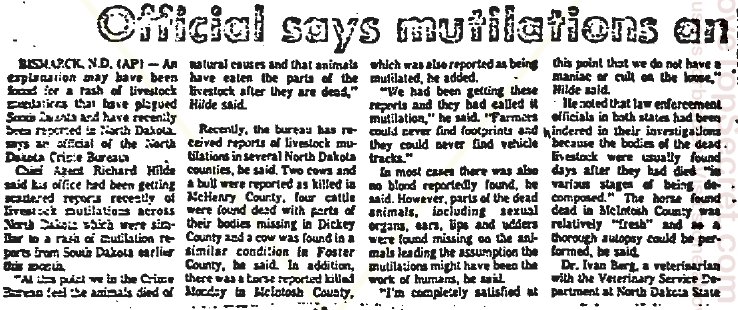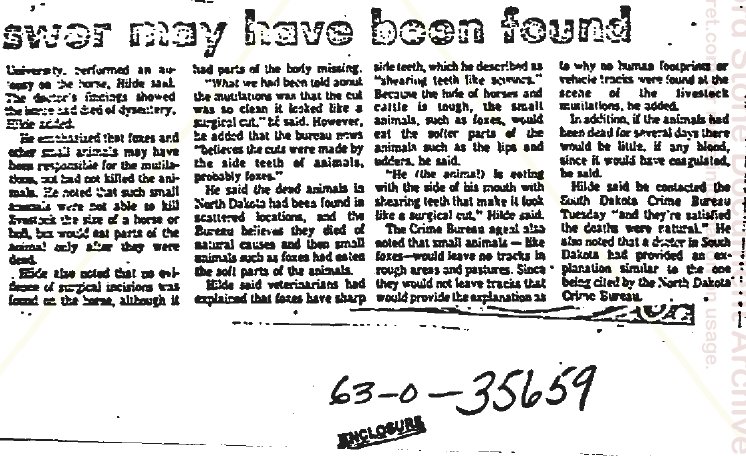

Bismark, N.D. (AP) — An explanation may have been found for a rash of livestock mutilations that have plagued South Dakota and have recently been reported in North Dakota, says an official of the North Dakota Crime Bureau.
Chief Agent Richard Hilde said his office had been getting scattered records recently of livestock mutilations across North Dakota which were similar to a rash of mutilation reports from South Dakota earlier this month.
"At this point we in the Crime Bureau feel the animals died of natural causes and that animals have eaten the parts of the livestock after they are dead," Hilde said.
Recently, the bureau has received reports of livestock mutilations in several North Dakota counties, he said. Two cows and a bull were reported as killed in McHenry County, four cattle were found dead with parts of their bodies missing in Dickey County and a cow was found in a similar condition in Foster County, he said. In addition, there was a horse reported killed Monday in Mcintosh County, which was also reported as being mutilated, he added.
"We had been getting those reports and they had called it mutilation," he said. "Farmers could never find footprints and they could never find vehicle tracks."
In most cases there was also no blood reportedly found, he said. However, parts of the dead animals, including sexual organs, ears, lips and udders were found missing on the animals leading the assumption the mutilations might have been been the work of humans, he said.
"I'm completely satisfied at this point that we do not have a maniac or cult on the loose," Hilde said.
He noted that law enforcement officials in both states had been
ed in their investigations because the bodies of the dead livestock were usually found days after they had died "in various stages of being decomposed." The horse found dead in McIntosh County was relatively "fresh" and so a thorough autopsy could be performed, he said.
Dr. Ivan Berg, a veterinarian with the Veterinary Service Department at North Dakota State University, performed an autopsy on the horse, Hilde said. The doctor's findings showed the horse had died of dysenttery, Hilde added.
He emphasized that foxes and other small animals may have been responsible for the mutilations, but had not killed the animals. He noted that such small animals were not able to kill livestock the size of a horse or bod, but would eat parts of the animal only after they were dead.
Hilde also added that no existence of surgical incisions was found on the horse, although it had parts of the body missing.
"What we had been told about the mutilations was that the cut was so clean it look like a surgical cut," he said. However, he added that the bureau news "believes the cuts were made by the side teeth of animals, probably foxes."
He said the dead animals in North Dakota had been found in scattered locations, and the Bureau believes they died of natural causes and then small animals such as foxes had eaten the soft parts of the animals.
Hilde said veterinarians had explained that foxes have sharp side teeth, which he described as "shearing teeth like scissors." Because the hule of horses and cattle is tough, the small animals, such as foxes, would eat the softer parts of the animals such as the lips and udders, he said.
"He (the animal) is eating with the side of his mouth with shearing teeth that make it look like a surgical cut," Hilde said.
The Crime Bureau agent also noted that small animals — like foxes — would leave no tracks in rough areas and pastures. Since they would not leave tracks that would provide the explanations as to why no humans footprints or vehicle tracks were found at the scene of the livestock mutilations, he added.
In addition, if the animals had been dead for several days there would be little, if any blood, since it would have coagulated, he said.
Hilde said he contacted the South Dakota Crime Bureau Tuesday "and they're satisfied the deaths were natural." He also noted that a doctor in South Dakota had provided an explanation similar to the one being cited by the North Dakota Crime Bureau.